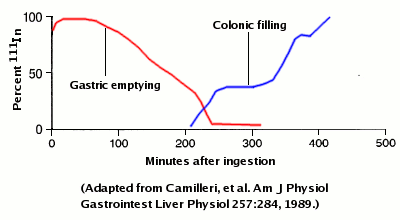How long does food stay in my stomach? How long is it before a meal reaches the large intestine? The answer to such commonly-asked questions is not necessarily simple.
First, there is considerable normal variability among healthy people and animals in transit times through different sections of the gatrointestinal tract. Second, the time required for material to move through the digestive tube is significantly affected by the composition of the meal. Finally, transit time is influenced by such factors as psychological stress and even gender and reproductive status.
Several techniques have been used to measure transit times in humans and animals. Not surprisingly, differing estimates have been reported depending on the technique used and the population of subjects being evaluated. Some of the techniques used include:
- Radiography following a barium-labelled meal. Sequential radiographs can be used to determine when the front of the barium label reaches different regions of the digestive tube. Such meals are not very physiologic and the technique exposes the patient to repeated exposure to radiation.
- Breath hydrogen analysis. A number of carbohydrates are very poorly digested or absorbed in the small intestine, but readily fermented by bacteria when they reach the large intestine. Fermentation liberates hydrogen gas, which diffuses into blood and is exhaled in breath, where it can be readily measured. Thus, after consumption of a meal containing a non-absorbable carbohydrate (lactulose or, more commonly, baked beans), there is a large increase in exhaled hydrogen when the carbohydrate reaches the large intestine. This provides an estimate of pre-colonic (stomach plus small intestine) transit time.
- Scintigraphic analyses. Meals containing pellets or colloids labelled with a small amount of radionuclide (99mTechnetium, 113mIndium, etc.) are consumed, and the position of the radioactive label is sequentially monitored using a gamma camera.
Studies of gastrointestinal transit have clearly demonstrated two related phenomena important to understanding this process:
- Substances do not move uniformly through the digestive system.
- Materials do not leave segments of the digestive tube in the same order as they arrive.
In other words, a meal is typically a mixture of chemically and physically diverse materials, and some substances in this mixture show accelerated transit while others are retarded in their flow downstream.
An example of how ingested substances spread out in the digestive tube rather than travel synchronously is shown in the figure below. These data were obtained from a human volunteer that ingested a meal containing 111Indium-labeled pellets, then measuring the location of the radioactive signal over time by scintigraphy. It is clear that parts of the meal are entering the colon at the same time that other parts are still in the stomach.

The discussion above should help to explain why it is difficult to state with any precision how long ingesta remains in the stomach, small intestine and large intestine. Nonetheless, there have been many studies on GI transit, and the table below presents rough estimates for transit times in healthy humans following ingestion of a standard meal (i.e. solid, mixed foods).
| 50% of stomach contents emptied | 2.5 to 3 hours |
| Total emptying of the stomach | 4 to 5 hours |
| 50% emptying of the small intestine | 2.5 to 3 hours |
| Transit through the colon | 30 to 40 hours |
Remember that these are estimtes of average transit times, and there is a great deal of variability among individuals and in the small person at different times and after different meals.
sursa: Author: R. Bowen



Niciun comentariu:
Trimiteți un comentariu